Site menu:

December 2011 Newsletter
Species Spotlight - Scaup.
November Bird News.
Forthcoming Events.
Latest Newsletter.
Species Spotlight - Scaup
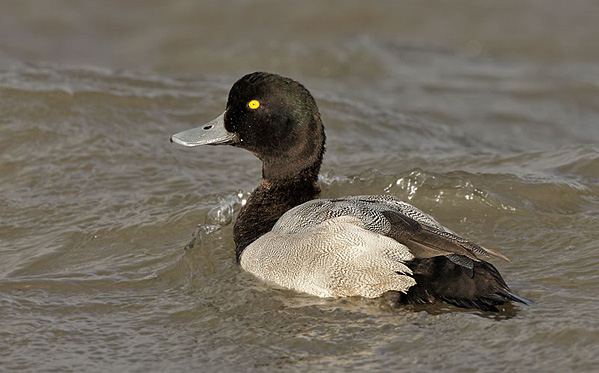
The Scaup (otherwise know as Greater
Scaup) has become quite a scarce bird in our area so it was
good to
see a flock of 70 to 96 last winter (2010/11) which were present off
Hilbre and North Wirral for several weeks. Although not as many birds
were involved the same happened the previous winter (2009/10), perhaps
these are birds dispersing away from a frozen Baltic Sea after the
colder than normal weather. The max count last winter was 96 off Meols
on Jan 31st, the highest count since 2001 when there were 188, although
this latter count was of a transient flock and it hasn't been since
1996 that we've had a sizeable flock overwintering here. About 30 were
still present off north Wirral in the second half of March this year
(2011).
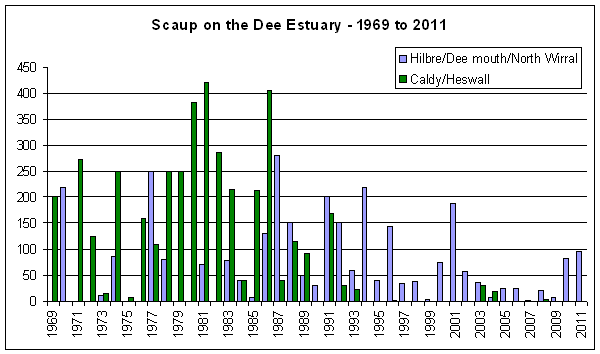
There was a time when the Dee Estuary had the highest counts in England and Wales; in the 1960s, 70s and into the 80s. Over that period there used to be good size flocks feeding at high tide on Caldy Blacks, the mussel bed off Caldy, although often the flock was in the middle of the estuary and difficult to count. The graph above probably underestimates numbers at Hilbre as the reports didn't always make clear where the birds were seen from although it seems that often the birds drifted out towards Hilbre on the ebbing tide. For a short period in the late 1940's much larger numbers occurred with the highest count being 5,000 in 1949, comparable to the largest flocks currently occurring in Northern Ireland and Scotland. Nothing like these numbers have appeared here subsequently and during the 1950s there was a big drop in Icelandic breeding birds, so maybe that is where those birds had come from.
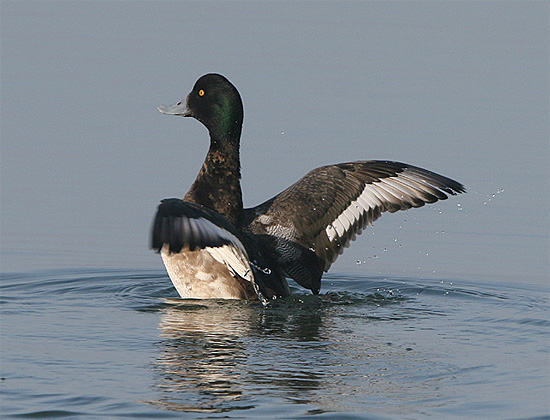
The Scaup breeds right across the northern hemisphere. There are two subspecies - Aytha marila marila which breeds in Iceland, Scandinavia and east to western Siberia, and A. m. neartica which breeds in eastern Siberia, Alaska and northern Canada. It was estimated that numbers wintering in western Europe (all Aytha marila marila) were around 310,000 up until about 20 years ago but they have since declined. Only a small portion of these winter around the British Isles; a few thousand around Ireland and Scotland, with smaller numbers around England and Wales, including the Dee Estuary. Ringing recoveries indicate birds wintering in this country breed in both Iceland and northern Europe although the majority are thought to come from Iceland. Around 5,000 are found on Lough Beg and Neagh in Northern Ireland, just across the Irish Sea from the Dee Estuary; recent increases there have been attributed to a recovery in the Icelandic breeding population.
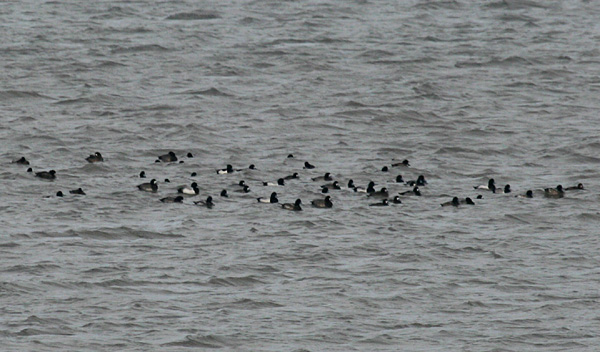
References/Sources of Information:
1. Cheshire Bird Reports 1964 to 2009.
2. Latest Sightings archive - www.deeestuary.co.uk (many thanks to
everyone
who sent their sightings to me).
3. Waterbird Population Estimates, Fourth Edition, AEWA, 2006.
4. BTO Migration Atlas, 2002.
5. David Cabot, Wildfowl, New Naturalist No.110, Collins, 2009.
6. A.J. Prater, Estuary Birds of Britain and Ireland, T&AD
Poyser, 1981.
7. T. Hedley Bell, The Birds of Cheshire, Sheratt, 1962.
Richard Smith
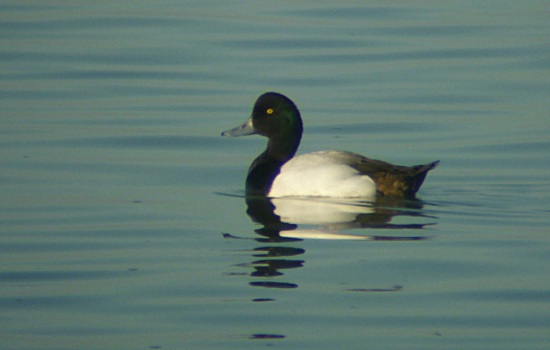
November Bird News
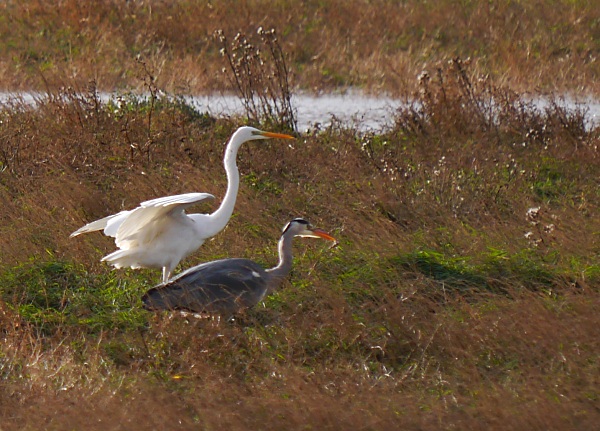
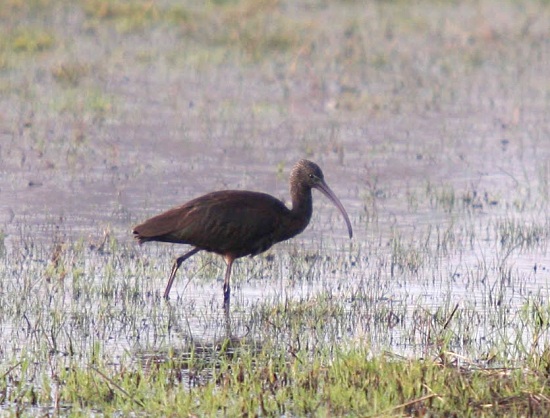
On Burton Marsh there were lots of Short-eared Owls, including two counts of 20. At least four Hen Harriers were recorded, three ringtails and a sub-adult grey male, and possibly a full adult male as well. A Spoonbill was reported several times on the marshes on both sides of the estuary, although somewhat elusive, and a Bittern was spotted at Burton Mere Wetlands on the 9th. A large flock of Twite were reported from Connah's Quay and Oakenholt Marsh with max 75 on the 25th.
Given the mild conditions wader numbers were reasonably high with max counts as follows: 3,000 Black-tailed Godwits at Point of Ayr, and 11,000 Knot and 9,000 Dunlin at West Kirby. Purple Sandpipers had reached 20 on the pontoon on New Brighton Marine Lake by the end of the month with another 15 at Hilbre. Up to 1,500 Black-tailed Godwits were also at Thurstaston were 20 different colour-ringed birds were logged.
There seemed to be a bit of an influx of European White-fronted Geese into the country with several small flocks reported away from their usual haunts in the south of England, we had some at Burton Mere Wetlands, with max 14 present for several days.
The southerly winds strengthened towards the end of the month, and we also had a few days of westerly gales resulting in some good seawatching. Highlights were several Great Skuas, max six flew past Hilbre on the 25th with 25 Red-throated Divers on the 28th and a Great Northern Diver there on the 9th. I'm pretty sure that the 192 Gannets counted on the 25th is the highest ever recorded for November, many years none at all are seen so late in the year. Earlier in the month one Pomarine skua was seen eating a dead auk off Hilbre on the 9th.
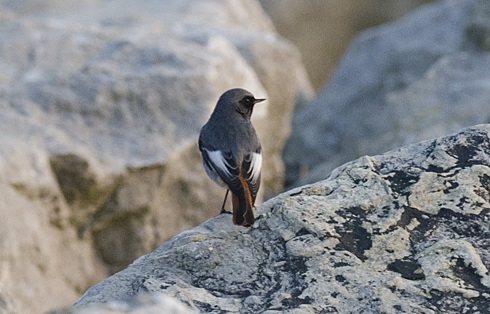
Richard Smith.
What to expect in December
Whatever the weather the birdwatching will be good on the estuary with a build up of both waders and wildfowl. Along north Wirral low tide off Leasowe is a good site to see feeding waders with thousands of Knot and Bar-tailed Godwits. A calm day at high tide will mean the hundreds of Great Crested Grebes will be visible off Hoylake, Meols and Leasowe - there should also be Scoters and Red-throated Divers out there. Hopefully we will get Scaup returning again and Meols shore is usually a good spot see these at high tide, as well as Hilbre.
Further west along the shore Hoylake and West Kirby will be spectacular at high tide with thousands of roosting waders. Brent Geese and Purple Sandpipers numbers will be building on Hilbre, New Brighton is also a good place to see the latter on a high tide on the pontoon in the Marine Lake.
Thurstaston shore is a great place to see feeding Knots and both Bar-tailed and Black-tailed Godwits when the tide is out - as well as good numbers of Pintail, Shelduck and Teal. Out on the marshes off Parkgate and Burton you should see Hen Harriers, and this winter looks like a particularly good one for Short-eared Owls. Pink-footed Geese and swans will be in good numbers feeding on Shotwick Fields, or out on the marshes.
Prime spots on the Welsh side of the estuary are the Connah's Quay Reserve (members only) and Flint Castle. Both these sites are good for Twite as well as for waders and wildfowl. The beach at Point of Ayr is usually the best site on the estuary to see Snow Buntings, the wader roost here can be spectacular for both waders and wildfowl, and there is always a good chance of a Short-eared Owl over the lagoon.
Forthcoming Events
December Highest Spring Tides (Liverpool)
Also
see Tides
page.
25th December, 11.10hrs (GMT), 9.6m.
26th December, 11.56hrs (GMT), 9.7m.
27th December, 12.39hrs (GMT), 9.6m.
Forthcoming Events
Organised by the Wirral
Ranger Service , Flintshire Countryside Service and/or the
RSPB:
All these events and walks have bird interest, even those not
advertised specifically for birdwatching. No need to book for these
events unless specified - please check below.
Also see 2011 Events Diary.
The
Dee Estuary Nature Reserve is a vital wintering grounds for many birds
of prey – Discover these impressive birds in their wild habitat,
hunting and roosting on the saltmarsh.
Warm clothing and binoculars recommended. Ring 0151 336 7681 for
further information.
|